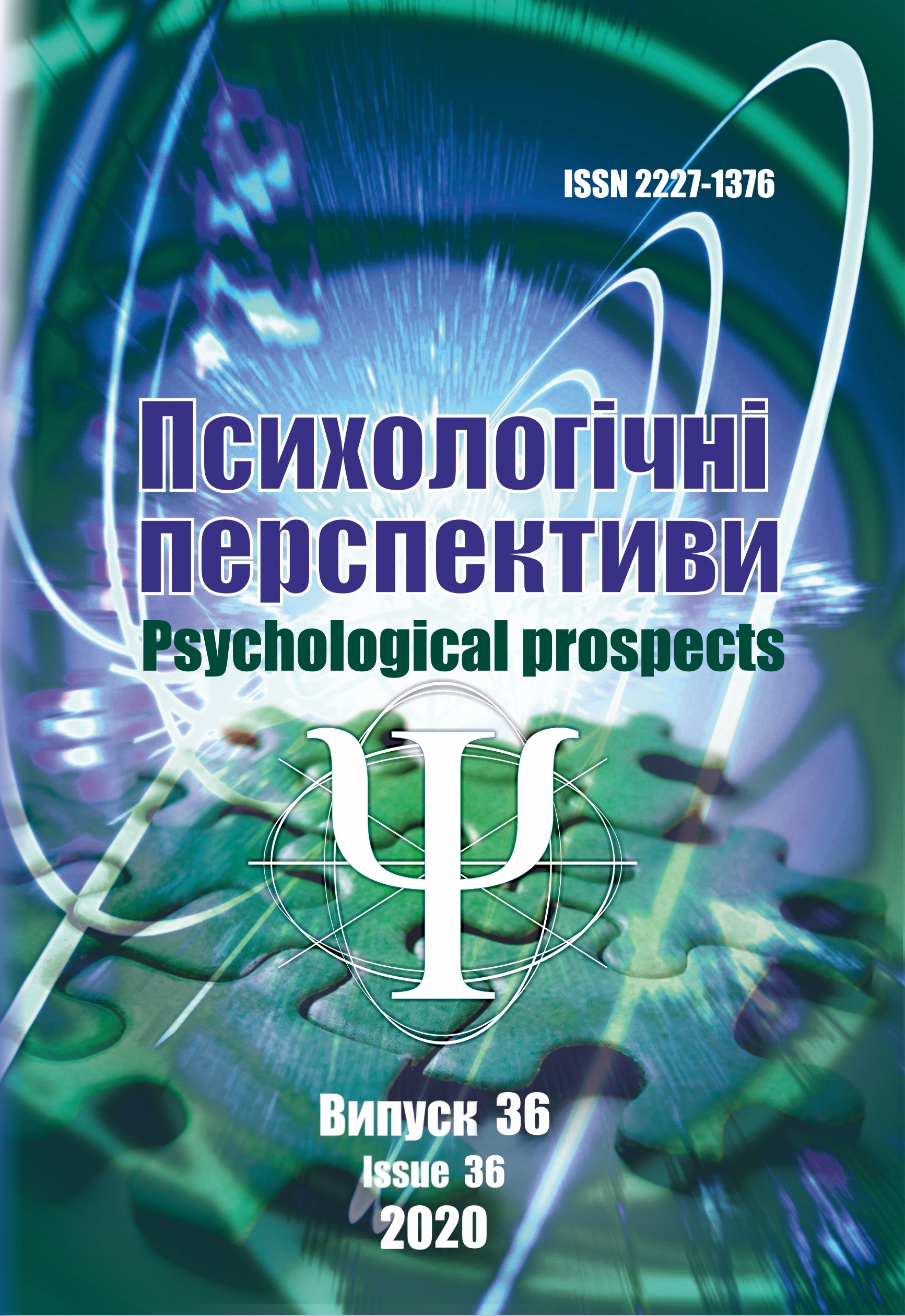Kenny Music Performance Anxiety Inventory (K-MPAI-R): Confirmatory factor analysis of the Ukrainian version
DOI:
https://doi.org/10.29038/2227-1376-2020-36-144-158Keywords:
measurement, musicians, performance anxiety, validity, reliability, K-MPAI, factor structureAbstract
Purpose. Рerformance anxiety is one of the most central psychological problems in the professional activity of musicians. However, in Ukrainian clinical practice and research there is a lack of valid tools to assess it. This publication presents the results of psychometric analysis of the Ukrainian version of K-MRAI-R (revised Kenny Music Performance Anxiety Inventory). Based on Barlow’s theory of anxiety desorders, this measure assesses cognitive, affective, physiological and behavioral symptoms of music performance anxiety and its etiological aspects. The purpose of this study was to confirm the factor structure through a confirmatory factor analysis and determine its reliability by the Cronbach's alpha criterion. Methodology. The study involved Ukrainian tertiary music students and professional musicians (age 18-72, M = 35.32, SD = 13.28; 63% women and 37% men) from different regions of Ukraine. Results: Results showed that the Ukrainian version of K-MRAI-R consisted of high psychometric indicators, validated through a confirmatory factor analysis. CFA did not support either of the two-, three- or eight-factor solutions. After excluding psychometrically poor items modified six-factor model proved to be a satisfactory fit (χ²/df = 1.75; CFI = 0.940 і TLI = 0.931; RMSEA =0.047; SRMR = 0.048). The high internal reliability of the questionnaire scales was confirmed by the Cronbach's alpha (a good level for sub-scales «рroximal somatic anxiety» (.864), «worry/dread (negative cognitions) (.818), «depression/hopelessness» (.742), «anxious apprehension» (.839), and an acceptable level for sub-scales «рarental empathy» (.645), «generational transmission of anxiety» (.658). Conclusions. The Ukrainian version of K-MPAI-R may be used as a reliable and valid psychodiagnostic tool to provide diagnostical care and research music performance anxiety. Prospects for further research of the Ukrainian version of K-MRAI-R are to verify its convergent and divergent validity, test-retest reliability.References
Barlow D. H. (2002). Anxiety and its disorders: The nature and treatment of anxiety and panic (2nd ed.). New York: The Guilford Press.
Barbar A.E.M., Crippa JAS, Osório F.L. (2014). Performance anxiety in Brazilian musicians: Prevalence and association with psychopathology indicators. Journal of Affective Disorders. 152(154), 381-6. DOI: https://doi.org/10.1016/j.jad.2013.09.041
Barbar, A. E., Souza, J. A., & Osório, F. L. (2015). Exploratory factor analysis of Kenny Music Performance Anxiety Inventory (K-MPAI) in a Brazilian musician sample. Archives of Clinical Psychiatry (São Paulo), 42(5), 113–116. DOI: https://doi.org/10.1590/0101– 60830000000060
Brown, T. A. (2006). Confirmatory Factor Analysis for Applied Research. New York: The Guilford Press.
Chang-Arana, A. M. (2015). Adaptation and psychometric properties of the Kenny-Music Performance Anxiety Inventory (K-MPAI). Paper presented at the X Latin- American Regional Conference and III Pan American Regional Conference of Music Education, Lima, Peru.
Chang-Arana, A.M., Kenny, D.T., & Burga-León, A. (2018). Validation of the Kenny Music Performance Anxiety Inventory (K-MPAI): A cross-cultural confirmation of its factorial structure. Psychology of Music, 46, 551–567. DOI: https://doi.org/10.1177/0305735617717618
Cox, B. J., & Kenardy, J. (1993). Performance anxiety, social phobia, and setting effects in instrumental music students. Journal of Anxiety Disorders, 7, 49–60.
Faur A.L., Vaida S., Opre A. (2020). Kenny Music Performance Anxiety Inventory: Exploratory Factor Analysis of the Romanian version. Psychology of Music. Prepublished February, 6, 2020. DOI: https://doi.org/10.1177/0305735619896412
He, J., & van de Vijver, F. (2012). Bias and Equivalence in Cross-Cultural Research. Online Readings in Psychology and Culture, 2(2). DOI: https://doi.org/10.9707/2307-0919.1111
Kantor –Martynuska J., Kenny D.T. (2018). Psychometric properties of the Kenny-Music Performance Anxiety Inventory modified for general performance anxiety. Polish Psychological Bulletin, 49(3) 332–343. DOI: https://doi.org/10.24425/119500
Kenny, D.T. (2011). The Psychology of Music Performance Anxiety. Oxford: Oxford University Press.
Kenny, D. T. (2016). Music Performance Anxiety: Theory, Assessment and Treatment. LAP Lambert Academic Publishing.
Kenny, D. T., Davis, P. J., & Oates, J. (2004). Music performance anxiety and occupational stress amongst opera chorus artists and their relationship with state and trait anxiety and perfectionism. Journal of Anxiety Disorders, 18(6), 757-777. DOI: https://doi.org/10.1177/0305735612463950
Kenny, D. T. (2009). The factor structure of the Revised Kenny Music Performance Anxiety Inventory. In A. Williamon (Ed.), Proceedings of the International Symposium on Performance Science (pp. 37–41). Utrecht, The Netherlands: Association Européenne des Conservatoires.
Kline, R. B. (2016). Methodology in the social sciences.Principles and practice of structural equation modeling (4th ed.). Guilford Press.
Ksondzyk, O. (2020). Kenny Music Performance Anxiety Inventory (K-MPAI): Exploratory Factor Analysis of the Ukrainian version. Mental Health: Global Challenges Journal, 4(2), 39 - 44. DOI: https://doi.org/10.32437/mhgcj.v4i2.87
Lehrer, P. M., Goldman, N. S., & Strommen, E. F. (1990). A principal components analysis assessment of performance anxiety among musicians. Medical Problems of Performing Artists, 5(1), 12–18.
Osborne, M. S., Kenny, D. T., & Holsomback, R. (2005). Assessment of music performance anxiety in late childhood: A validation study of the Music Performance Anxiety Inventory for Adolescents (MPAI-A). International Journal of Stress Management, 12(4), 312–330. DOI: https://doi.org/10.1037/1072-5245.12.4.312
Peschke, S., & von Georg, R. (2015, August 17–22). The competence of performance: Mental aspects of succeeding and failing in musicians. Paper presented at the Ninth Triennial Conference of the European Society for the Cognitive Sciences of Music, Manchester, UK. DOI: https://doi.org/10.13140.RG.2.1.2547.6562
Rocha, S., Dias-Neto, E., & Gattaz, W. F. (2011). Music performance anxiety: Translation, adaptation and validation of the Kenny Music Performance Anxiety Inventory (K-MPAI) to the Portuguese language. Archives of Clinical Psychiatry, 38(6), 217–221. DOI: https://doi.org/10.1590/S0101-60832011000600001
Spahn, C., Walther, J., & Nusseck, M. (2016). The effectiveness of a multimodal concept of audition training for music students in coping with music performance anxiety. Psychology of Music, 44 (4), 893-909. DOI: https://doi.org/10.1177/0305735615597484
Spielberger, C. D. (1983). State-trait anxiety inventory STAI (form Y). Palo Alto, CA: Consulting Psychologists Press, Inc.
Downloads
Published
Issue
Section
License
Copyright (c) 2020 Ksondzyk Olena

This work is licensed under a Creative Commons Attribution-NonCommercial 4.0 International License.










